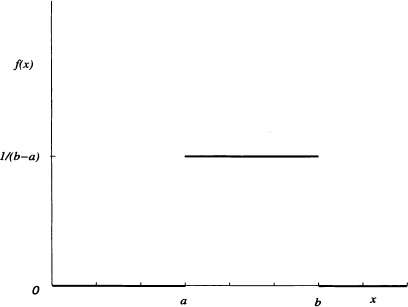CHAPTER 4
SOME CONTINUOUS DISTRIBUTIONS
In this chapter we will study some of the absolute continuous-type distributions most frequently used.
4.1 UNIFORM DISTRIBUTION
Suppose that a school bus arrives always at a certain bus stop between 6 AM and 6:10 AM and that the probability that the bus arrives in any of the time subintervals, in the interval [0,10], is proportional to the length of the subinterval. This means it is equally probable that the bus arrives between 6:00 AM and 6:02 AM as it is that it arrives between 6:07 AM and 6:09 AM. Let X be the time, measured in minutes, that a student must wait in the bus stop if he or she arrived exactly at 6:00 AM. If throughout several mornings the time of the bus arrival is measured carefully, with the data obtained, it is possible to construct a histogram of relative frequencies. From the previous description it can be noticed that the relative frequencies observed of X between 6:00 and 6:02 AM and between 6:07 and 6:09 AM are practically the same. The variable X is an example of a random variable with uniform distribution. More precisely it can be defined in the following way:

Figure 4.1 Density function of a uniform distribution
Definition 4.1 (Uniform Distribution) It is said that a random variable X is uniformly distributed over the interval [a, b], with a < b real numbers, if its density function is given by:
The probability ...
Get Introduction to Probability and Stochastic Processes with Applications now with the O’Reilly learning platform.
O’Reilly members experience books, live events, courses curated by job role, and more from O’Reilly and nearly 200 top publishers.

